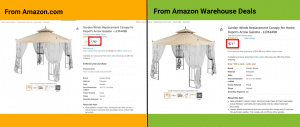The Complete Guide to Amazon Warehouse Deals for Buyers and Third-Party Sellers

Buyers are always searching for great deals online. If you don’t mind a few dents and scratches on your orders, then Amazon Warehouse Deals is a good place to start looking.
In this article, we’ll examine the advantages and risks involved in buying from AWD as well as how it affects third-party sellers and their brands.
What Are Amazon Warehouse Deals?
Amazon Warehouse Deals (AWD) is a way for Amazon to offer discounted warehouse-damaged, returned, open-box, and pre-owned products on the platform. This means that whatever items that are either returned by customers or whose packaging is damaged by Amazon that it thinks is still good enough to sell make it to the Warehouse Deals.
Based on the Buy Box, AWD is a seller in its own right, but it is part of Amazon.com and owned by Amazon.
In general, products sold on Amazon Warehouse are cheaper than those sold new on Amazon.com, even if the latter is discounted.

However, while this is the case, the availability of products on Amazon Warehouse Deals is not guaranteed, and customers get the items on a first come, first served basis. This is expected, of course, because Amazon does not control what customers return and (to an extent) what items gets damaged in its warehouses.
To buy from Amazon Warehouse, you can
- Visit the Amazon Warehouse home page or
- Go to Amazon.com, click on the drop-down menu, and select Amazon Warehouse
The rest of the process is the same as buying from Amazon.com or any of its other marketplaces.
Orders are still covered by Amazon’s returns policy. This means that items can be returned within 30 days from receipt of the shipment. Additionally, you can still use the benefits of your Prime membership, so you can take advantage of Amazon’s two-day shipping and reduced shipping costs.

Is Buying from Amazon Warehouse Deals Risky?
Generally, no.
Products sold by Amazon Warehouse are almost always good enough. A lot of the items, especially in the Used – Like New category only have packaging damage, but the product is still good as new. (This is great for personal use, but maybe not so much as a gift.)
Let’s say someone buys an iPhone. They open it only to realize that it has the wrong specs, e.g., just 64GB instead of 256GB, when they clearly ordered the latter. Obviously, because the box has already been opened, Amazon can’t—in good conscience—sell it as new. Items like this are then sent to the warehouse and evaluated and graded using a 20-point quality process and categorized (more on this on the next section). Then they are relisted for a discounted price.
Some issues from Amazon Warehouse Deals include missing instruction manuals, dented packaging, and minor scratches.

As mentioned earlier, your orders are still covered by Amazon’s returns policy. However, most products aren’t covered by a manufacturer’s warranty (because they’re sold as used and repackaged). However, you can extend your warranty by using extended warranty service providers like SquareTrade.
Amazon Warehouse Deals Product Conditions
Returned items or those that are damaged while in the warehouse are examined, and Amazon determines whether the products are still sellable. When they pass the test, they are categorized into the following:
| Used – Like New | An item in perfect working condition, the packaging may bear some damage. The item fully functions, and all its essential accessories are complete. |
| Used – Very Good | An item in very good condition that may have seen limited use and fully functions. The item may have minor cosmetic imperfections. It may arrive with damaged packaging or be repackaged and could be missing some non-essential accessories. Missing accessories are shown under individual item description. |
| Used – Good | An item in good condition that may show wear from moderate use and fully functions. The item may arrive with damaged packaging or be repackaged. It may have minor cosmetic damage, such as a small scratch. The item may be missing some valuable accessories and it may not be used until those accessories are purchased separately. Missing accessories are shown under individual item description. |
| Used – Acceptable | An item may have clear signs of usage but still serves its main function. Item may arrive with damaged packaging or be repackaged. The item may have cosmetic damages on it or show other signs of previous use. Signs of usage can include scratches, dents, and worn corners or edges. The item may be missing some valuable accessories, components or spare parts, and it may not be used until those parts are purchased separately. Missing parts are shown under individual item description. |
Source: Amazon Warehouse Deals
You can find the product’s condition on the listing itself or by clicking on the other options.

Pros and Cons of Amazon Warehouse Deals
Pros of Amazon Warehouse Deals
- Cheaper
- Most goods function properly
- Backed by Amazon’s return policy
- Better for the environment because you’ll be using items instead of destroying them or throwing them away
- Protected by Amazon’s A-z Guarantee
Cons of Amazon Warehouse Deals
- No manufacturer’s warranty
- Availability of items is not guaranteed
How Does Amazon Warehouse Deals Affect Third-Party Sellers?
Amazon Warehouse Deals may be a good news for buyers, but they can be a concern for third-party sellers. Amazon reselling your items as used is not a case of unauthorized selling, unfortunately. It’s completely legal to do so, which makes it disadvantageous for your brand if there’s an unsatisfied customer who decides to review the product.
Remember that unlike sites like eBay, Amazon allows only one listing for one type of product. Other sellers can just piggyback on the existing listing if they’re selling the same item. So if you’re a third-party seller who has your own brand, any negative reviews will be reflected on your listing.
This usually happens when Amazon miscategorizes a product as sellable or when it commits errors in categorizing which condition to indicate in the listing, e.g., an item is advertised as Used – Like New and in the customer’s opinion, it does not belong in that category. In other words, sellers have no control over customer experience because technically, they are not the official sellers for those transactions.
Amazon also may reimburse you for your lost or damaged products, but this does not mean that you get the maximum profits possible. Sellers regularly reprice their products, so Amazon looks at several factors, including average selling price and sales history. Fees are also subtracted from the reimbursement, which further reduces the amount.
What Can Third-Party Sellers Do Against Amazon Warehouse Deals?
Unfortunately, there is no way to absolutely prohibit Amazon from selling your products as used. Technically, they paid for it, so there’s already a transfer of ownership. However, there is a way to lessen the number of your products that end up on Warehouse Deals—by disabling refurbishments on Seller Central.
To do this, go to Settings → Fulfillment by Amazon. From here, scroll down and find “Automated unfulfillable settings,” click on Edit, and disable Refurbishments.
When Refurbishments is enabled, your product will go through the following process:
Amazon enables refurbishments by default, so you will have to disable this manually.
Conclusion
Amazon Warehouse Deals have advantages and disadvantages for both buyers and third-party sellers. Customers are provided with great deals for used products while sellers don’t need to worry about returns.
Overall, Amazon Warehouse is a good way to give products a second chance and is much better for the environment than Amazon just destroying products that could have been put to good use.
Did you have a bad experience with AWD? How did Amazon handle your complaint? Tell us in the comments section below.









Even though Amazon’s products are at lower price points than most competitors, they have a number of ways to save additional money.